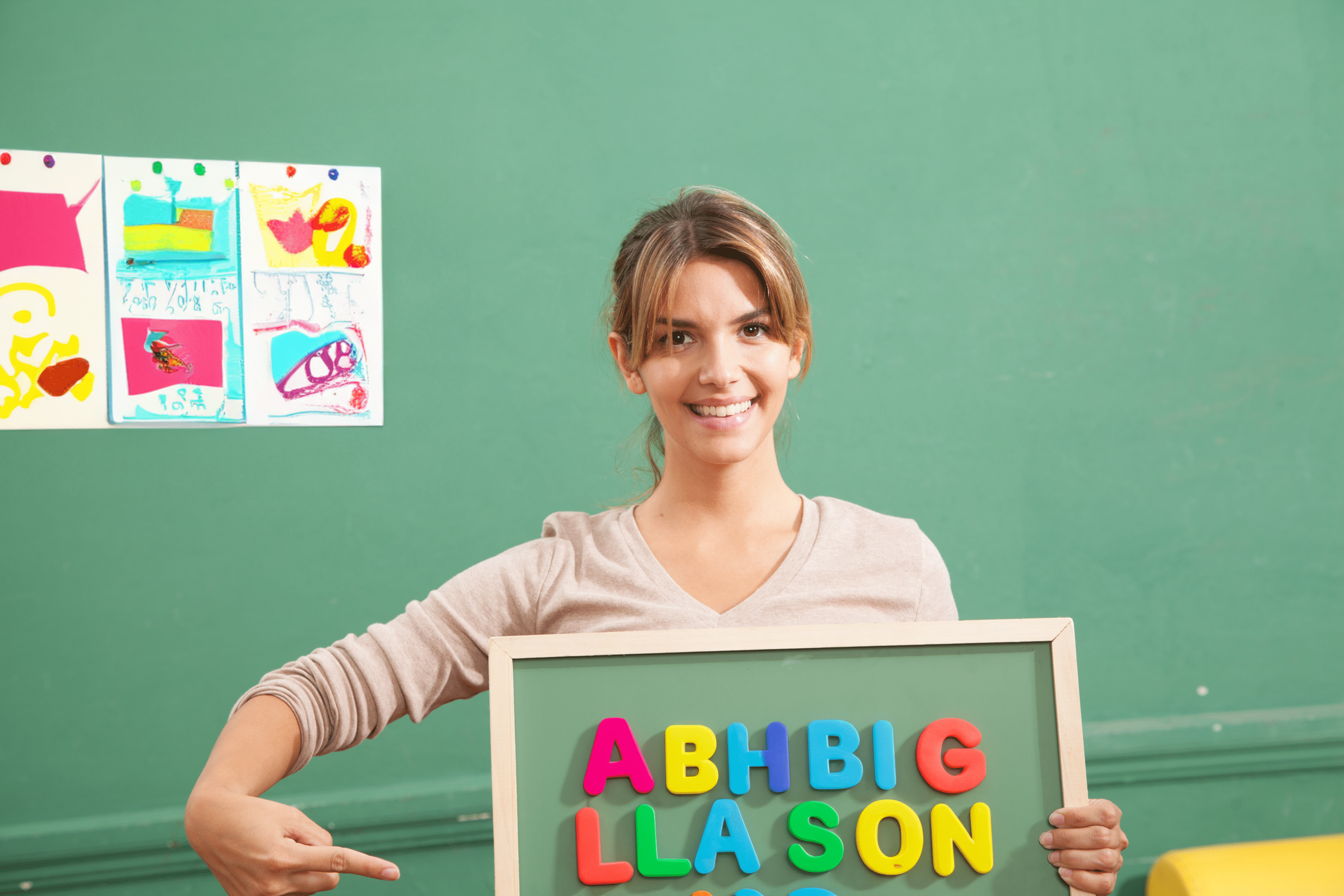Welcome. As you may know, the quality of reading instruction across the U.S. is uneven, so it’s a good idea to get involved. The article here is for parents who want to give their children a head start. The advice below stems from 14 years of teaching experience and careful records that showed which techniques worked—and which ones worked better. Wherever our advice is surprising, we’ve included some of the reasons for our assertions.
Birth to 5 years of age
DON’T RUSH #1: Early Brain And Speech Development
Good parents often want to start reading instruction too early. Don’t be fooled by “My Baby Can Read” and similar products. “My Baby Can Read” is all about memorization. At Bristol Standard, we strongly oppose unnecessary memorization. Word memorization won’t work on most children (regardless of age) and can cause prolonged reading problems. It also teaches children to guess when they see short words. For some children, memorization appears to work because they slowly deduce the letter sounds and the main rules of phonics. This fools many teachers into supporting Whole Word “memorization,” and that has been the situation since the 1930s.
During a child’s first few years of language development, the brain is learning to recognize and imitate the speech sounds the child hears most often. Unless your child is way, way ahead of other children, this is not the time to begin teaching reading. If your child is way ahead, there is no need to teach reading skills because your child will almost certainly learn to read easily when it’s time to start. The link below takes you to an article from the Stanford School of Medicine. It covers typical language development milestones: https://tinyurl.com/Stanford014
DO: PREPARE YOUR CHILD FOR READING INSTRUCTION
When your child is between the ages of zero and four, you should be working on his or her basic language skills. Try to beat the milestones in the article linked above. During this period, your child is soaking up speech sounds, vocabulary, grammar, and subtle intonation patterns that can alter meaning radically. To prepare your child, you should focus on talking to your child constantly. Rare television exposure may help a little, but it’s far more effective when you talk to your child. He or she will instinctually orient towards your face, watch your lips and facial expressions, listen intently, and try to respond with babbling, facial expressions, other body language, and eventually, short sentences—depending on age.
Television can be very bad for your child: Some parents discourage talking because they want to watch or hear their favorite TV and radio programs. This prevents your child from learning to speak. Your child doesn’t get much practice speaking at school because his teachers are constantly telling him to be quiet so they can teach. Also, young children don’t pay much attention to adult television, since the programming adults prefer is way too advanced. Children’s TV programming doesn’t help much with language skills because these are learn-by-doing skills and TV is a passive activity. Finally, your child may not yet understand the two dimensional representations of three-dimensional scenes a TV displays.
When you are with your child, you can focus on describing what you are doing: walking, standing, drawing, toasting, opening the window, turning on the lights, etcetera. As you describe your activities, your child learns new nouns and verbs. Away from home, you can also focus on what you see and what’s happening. When you work with objects, you can model complex grammar. “I’m picking up the red cube and placing it on the green one in order to build a stack of three cubes.” “Now I’m finishing the stack of three cubes by placing the third cube on the green cube I placed on the red one.” Follow up with instructions or questions: “How many cubes are there in the stack?” “What color is the bottom cube?” Always encourage answers that are complete sentences. Your child will start with three-word sentences. Don’t bother correcting mistakes; the impact of corrections is minimal. Instead encourage doing and saying. You are building vocabulary and grammar your child will recognize and understand later when he’s reading.
If your household is lucky enough to include someone who speaks a foreign language, you can raise a bilingual child by making simple adjustments beyond the scope of this article. Contact us for tips. You can also visit our page for Spanish speakers.
If you are working at home or listening to an important radio or TV program, consider playing music for your child in another room. It’s not language, but it stimulates some of the same hearing centers and promotes the growth of connections between neurons and specialized input processing centers called “ganglions.” If your plans include a daycare or learning center, find out their policies on sight words, letter names, speaking, teaching, playing, and outdoor activities. Your ideal daycare encourages speech and doesn’t encourage word guessing or word memorization. Consider a Montessori school. No matter what type of environment your child is in, you should visit often. When you’re out for the evening, a well-chosen babysitter can work wonders.
DON’T TEACH THE ALPHABET OR LETTER NAMES
It’s a good idea to teach the alphabet song’s TUNE. The songs “Ba Ba Black Sheep” and “Twinkle Twinkle Little Star” both have the same tune, so feel free to teach these songs and their lyrics. The problem with letter names is that they’re used for spelling. Unfortunately, spelling is not reading. Saying “See, Ay, Tea” is completely different from saying “cat.” If you teach your child 26 letter names, it’s like teaching your child a series of 26 wrong answers. One problem with that is that people tend to remember best what the learned first.
Children who easily learn letter names also tend to learn letter sounds easily. On average, their parents are also more involved in schooling. Due to these factors, teachers notice that children who already know their letter names learn to read faster—due in equal parts to parental support and high reading aptitudes. This makes teachers think knowing letter names helps learn letter sounds, which is simply wrong. Don’t handicap your child with letter names. If you submit to this urge, your child will make far more reading mistakes over his first two years of school. Instead of saying “cat,” he might make any of the following mistakes: See-at (C-at), cattY (ca-T), or even Kate (c-AY-t). Each answer includes one letter name substituted for a letter sound. Letter name memorization lowers reading comprehension dramatically by promoting these substitutions.
After A Child’s Fifth Birthday
DO: TEACH THE MOST COMMON LETTER SOUNDS
Evolution did not design brains for reading. However, your child’s brain is innately wired to associate every object he or she sees with a word for that object. When either you or your child point at an object, your child’s brain is instinctually waiting to learn what that object is called. -So, if you point at a plastic letter and say /sss/ (the sound, not the letter name) your child will think that /sss/ is what an object of that shape is called. That’s progress because he or she now associates a plastic letter with the speech sound it represents.
You want to buy a set of plastic refrigerator letters for your child around age five. You need a set with at least two of every lowercase letter, so you can spell words like “did,” “mom,” and “pup.” In nearly any sentence, all the letters are lowercase except for the very first one. This makes lowercase letters much more useful for reading. Therefore, take all the uppercase letters out of the set and put them away. Later, your child will learn the capital letters easily without needing your help. He or she will also learn letter names without your help. That’s partly because everyone else thinks they’re essential.
The first object name your child hears is the object name he will learn and recall most easily. –So if you initially call your carpet “the rug,” you child will also call it “the rug.” It may be a long time before he tries calling your rug “the carpet” or “the floor.” The same thing is true for letters. If you point at a letter and say, “that’s an em (M), he will learn to say “em” when he sees that letter, but you don’t want him to say “emm” when he’s reading. You want him to say “mmmm,” so he can sound out map. Therefore, you say things like: “hand me the mmmm” or “what color is that mmmm?” or “which one is the mmmm?”
Children instinctually imitate their parents, so he will quickly begin saying mmmm when referring to the plastic shape on your fridge. Again, that’s progress. The fact your child thinks “mmmm” is the word for a refrigerator magnet in the shape of a lowercase M will be a very minor problem when serious reading instruction begins. Some children learn their letter names with difficulty—but then can’t attach new sounds (the useful ones) to these same symbols. This is just 26 missed opportunities. If such a child had learned 26 letter sounds first, instead of 26 letter names first, he would have been halfway done learning to read.
Some children have trouble distinguishing between different written symbols, especially while they’re very young. A child’s occipital lobe (the part of the brain responsible for recognizing objects visually) may simply mature more slowly than average. That’s only a big deal if you make it one by starting reading instruction too early and teaching all 52 upper- and lower-case symbols at the same time.
DO: TEACH A FEW LETTER SOUNDS… BUT ONE AT A TIME
Put ONE letter on the refrigerator. Every time you pass it, point to it, and say “that’s a sssssss” or “that’s a /t/” Do not say the letter’s name and do not add any extra sounds. Many letters do not activate vocal cords when spoken: The sound of T is the same sound heard at the end of “cat.” It’s written /t/. The sound of T is not “tuh” and it’s not “tea.” Start with lowercase T. After a few days, say “what’s that?” -as you point at the letter. If your child says /t/, you’re on your way. When he’s got /t/, replace it with a lowercase S (a ssssssss, not an ess). When he’s got both of those, they can stay on the refrigerator together while you ask which one is /t/ or which one is /s/. Then take them off and substitute lowercase N (a nnnnnnn, not an enn). When your child can accurately reproduce all three of those letter sounds—even when all three are together on the fridge, you’ve made much more progress than you probably realize.
Since most schools teach “short” vowels first, you can teach some of those. The short vowels sound very similar to each other, so teach them one at a time in the following order to minimize confusion. Be satisfied if you can teach the first two.
e as in “eh, sonny?” “-edge,” & “Ed”
o as in on & hot
a as in at,
u as in up,
i as in it,
When your child knows four to six letters, you’ve taught your child that each letter has a unique sound. Now you can combine them to make so-called “nonsense” words. This will teach him or her how to blend sounds together smoothly. “Nonsense” words are just common letter patterns your child needs to know. “Ent” is not a word, but it’s part of thousands of words, words like “tent” and “talent”. Let’s say your child has learned, lowercase E, N, T, and S. Because these letters are so common, he has just learned the main sounds for 34% of all the letters he will ever have to say.
At this stage, the fastest way to teach the letter sounds is by combining them into new nonsense words—2-letters at a time, then 3 letters at a time. Most children must relearn to read from left to right every time you introduce a new letter—and again every time the word length grows. If your child can say “un,” reliably, swap the letters, point to the new “word” and say, “What’s that?” He won’t say “nuh” the first time, so you supply the answer and revisit n-u from time to time. He will soon realize that letter order is important.
If your child can blend two letters together from left to right with some consistency, he has graduated from isolated letters. Because of the way memory works, your child will learn far faster when working with two- and 3-letter sets than he can when working with isolated letters. If you must refer to an isolated letter, call it by its main sound (not its name). For example, G would be called “guh.” Certain letters can’t be pronounced without adding a trailing vowel sound. These are: b, d, g, j, l, r, & w. Don’t add “uh” to any others.
DON’T TEACH LOWERCASE B AT ALL
Because d and b look like bookends, your child will not be able to distinguish between d and b until he or she is reading from left to right consistently. Due to the natural properties of memory, that could easily take over a year. You will also postpone lowercase P. Lowercase b-p and d-p confusion are both fairly rare, so the main reason for postponing P is that other letters are much more common and useful. Lowercase Q (q) is an even rarer and less useful letter. It’s another potential source of confusion.
DO: AIM FOR LETTER-SOUND CONSISTENCY (which makes teaching with stories impossible)
When a child is learning his first letter sounds, the sounds of the letters must be consistent. Do not teach long vowels with silent E’s, t-h, o-a, t-c-h, other weird combinations—or hard letter combinations—like s-c-r as in “screen” or t-h-r as in “thrilled.” Always refer to a letter by its speech sound. For example, you might say, “Point to the /z/” or “draw me 3 /t/ sounds.”
In the early stages, you should still use isolated letters from time to time. That’s because you want to reinforce the idea that each letter has its own sound. So, in writing, you might have…
t, t, ti, ti, t, ti, t, ti, tiii, tiii, tiiiip.
–Or you might have:
it, i, it, i, it, i, i, i, iiit.
To help your child learn to blend letter sounds together, begin your letter pairs with vowels: on, in, en, an, un… ot, it, at, et, ut… oc, ic, ac, ec, uc. A vowel sound can be stretched out until your child recalls the next letter’s sound. Some of these pairs will be official words. Others will be “nonsense” words. Remember, you’re teaching letters, not words. Your child can memorize 26 letter sounds way faster than he can memorize tens of thousands of official words. If your child is making a lot of mistakes (more than 25% wrong answers), simplify the work by raising the amount of letter pair repetition and reducing the letter variety. You’ll probably be surprised by how simple you have to make it at first. Our earliest exercises have only two answers.
DO: CHANGE ONLY ONE LETTER POSITION AT A TIME (at first)
When a child is learning his letter sounds, high letter variety causes extreme difficulty, which makes reading stories more or less impossible for most children. To simplify things, change only the letter at the beginning of each word in a series. Then change only the last letter of each word in a series. When your child is coping well with all the letters he knows in both positions, you can introduce new letters (which will cause him to read out of order again). Change one letter position at a time until you can change two at a time. Do that until you can change both letter positions at once (or all three at once), then introduce another new letter.
Most children automatically assume that there will be a vowel after every consonant. Therefore, they can pronounce “set” but not “est,” “ets,” or “ste” as in “stent.” By working with these letter combinations early, you can emphasize the importance of saying the letters in order (no matter what the order is). Other examples: net, ten, ent, tent… sip, spi, isp, etc.
DON’T RUSH #2: (Emotions Matter)
Your child may not be ready for reading instruction when you start. The last part of the brain to mature is the frontal lobes. That’s where reasoning takes place. Frontal lobes also manage attention. If your child is too distractible when you start, just wait several months. At first, reading is just “decoding,” saying the sounds in the right order. It is pure symbolic reasoning at this stage—way too advanced for many five-year old minds. Imagine teaching a five-year old algebra or how to spell “squeamish.” In certain countries, the ideal time to teach a child to read is after he is seven years old—maybe even eight for some. Here in the United States, most schools start way too early—at four or five years old. If you know what you are doing and have a good reading program, it takes only about 36 to 120 hours to teach a child to read. It doesn’t need to take four years, but it might take that long if you start too early.
So what’s wrong with starting early? The earlier you start, the more frustrated your child may become. Let’s look at an extreme example. Suppose you start teaching your child when he’s three weeks old. His brain can’t distinguish a T from an O, a W from an M, or an I from an L. He misses every answer, but he senses that you are frustrated and upset. He has no idea what is going on, but he knows it’s not pleasant. Negative emotions form memory too.
You may be able to hide your impatience from an older child, but he knows when he made a mistake because you supplied the answer. Ten mistakes don’t matter, but 10 thousand mistakes will make your child think he or she is bad at reading. You could wind up with a child who knows how to read but has secretly promised himself that he never will… because he now hates reading. The ideal age to teach reading is when the child can reason well and knows English basics completely. Children with fully mature language skills and strong reasoning ability learn reading much faster than children who are marginally articulate and too young to reason well.
A child with fully mature language skills might be 10 years old, but if you wait until your child is ten to start reading instruction, some professional teacher will come along way before you start—and quite possibly botch things up because she is relying on confusing reading curriculum. Because the schools start reading instruction too early, you must also begin too early in order to limit the confusion caused by the poor reading curriculum found at typical schools. If you run a homeschool, you get to decide when reading instruction should start. If you think you may have started too early, you can always stop or call us. Some parents are surprised by how hard it is for children to learn how to read. It seems easy to us adults because we have a demonstrated talent and have been doing it for years.
DO: PREVENT MISTAKES—BY ANY MEANS NECESSARY
Children do learn from their mistakes, but that’s not a good thing. In reading, they learn to repeat their mistakes. Each pronunciation mistake raises the odds your child will make that same mistake again soon. This is another feature of memory. The neurons that triggered the first wrong answer remain fairly excited and will fire again at the drop of a hat—triggering another wrong answer and strengthening the new memory further. Much older children can “learn from their mistakes.” When their frontal lobes are fully mature, they can use reasoning to suppress their mistakes—even when memory instantly suggests wrong answers based on letter content alone. Very few five-year-olds can do this, so you should step in to prevent a likely wrong answer when you can see one coming.
One perfectly good way to prevent a mistake is simply to supply the correct pronunciation before the child has a chance to figure out the wrong one. The best way to prevent mistakes is to limit letter variety and teach with word patterns: e, en, ent. a, an, ant. Another good way is simply teaching in the morning or when the child is wide awake and in a good mood. Predicting which letter combinations will trigger mistakes is challenging, but it’s okay to provide “too many” answers. That’s because most children need several thousand exposures to a letter in order to recall that letter’s main sound instantly and reliably. Your occasional interjections dissipate like curls of cigarette smoke on a breezy day.
DON’T HAVE THE CHILD READ STORIES TO YOU
Most children must be reading on a fairly solid first-grade level before their ready for the huge word and letter variety of simple stories. If they start reading stories too early, typical teaching practices encourage them to ignore any sentence that wasn’t understood. This encourages a habit of ignoring reading mistakes. When such children get older, they can read pretty well but have low comprehension because they think sentences that don’t seem to make sense are normal.
DO: PREVENT NEARSIGHTEDNESS
Ever since the 1950s—if I recall correctly, scientists have been getting increasingly alarmed about childhood myopia. Early onset myopia seems to be correlated with rising levels of education in any society—but so are school lunches. One early theory was that focusing on tiny letters inside books caused nearsightedness. That doesn’t seem to be the problem. One study found that children who spent at least two hours per day outside were much less likely to need glasses. Several studies that point to this conclusion have been contradicted by other studies. The other studies often reached no conclusions. My money is on the first study. It said that low light levels caused nearsightedness. Studying this type of thing is hard. After all, how much time did your child spend outside last Tuesday?
For me, it stands to reason that staying inside a dimly lit grass hut or a dimly lit cave all day was not natural behavior for the children of our distant ancestors. They probably ran around outside all day. One researcher concluded that it wasn’t just exposure to intense light that was important. He thought intense blue light was the key to avoiding nearsightedness. Myopia can set in quite early. If it were my baby or toddler, I would make sure he was getting about three hours outside every day. I would keep that up until he was 10. Indoor light is way dimmer than outdoor light.
DO: GET READY FOR SCHOOL
Get your child’s hearing checked at least once before school starts. You should definitely give your child an annual vision check-up. When children aren’t seeing or hearing clearly, they have great difficulty learning to read. Don’t let reversible hearing problems stand in your way.
DO: FORM A RELATIONSHIP WITH THE TEACHER
Bring him or her polished apples and chocolate covered black cherries. Tell her about your experiences teaching your child. Tell her you are against word memorization. Find out what reading curriculum your school is using and look up what people say about it. Observe the class when reading is being taught. Compare your child to the rest of the class. A child will be proud of how well he reads if he is in the top third of his class. Pride will make him want to practice reading and show off. As soon as he can read stories fairly well, start taking him to the library. Don’t introduce him to video games before he has learned how to read on a third-grade level. If you’re not totally confident, get reading insurance.
DO: READ TO YOUR CHILD (all the way through college?)
Any parent who has reached the bottom of this article is probably already reading to his or her children. What you may not know is that you can and should read well above your child’s current reading comprehension level. You should aim to be a little above your child’s listening comprehension level. When the child doesn’t understand something, you can explain it to him or her. The whole time you keep reading to your child, you’re banking vocabulary and grammar that will help your child get to higher reading levels. Keep reading to your child all the way through third grade—at least. You can continue to read above your child’s reading comprehension level for several years beyond that if neither of you objects.







0 Comments